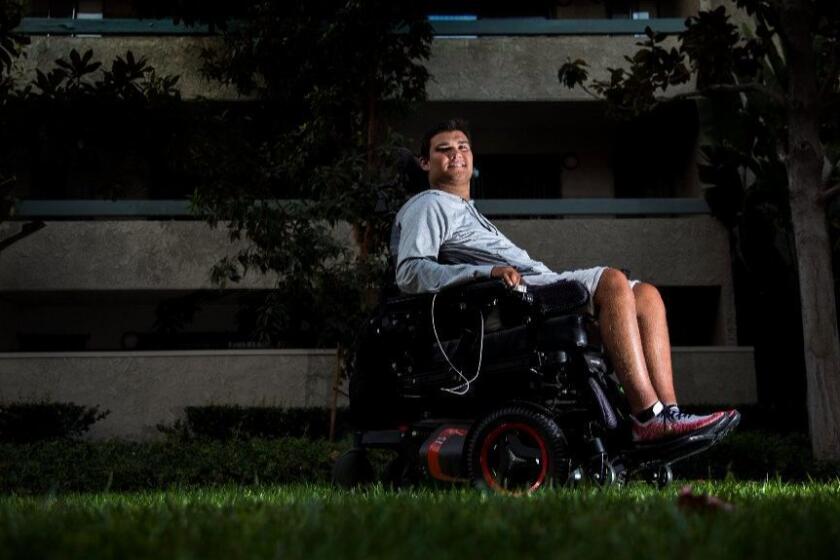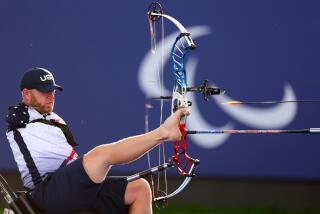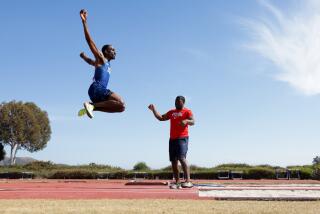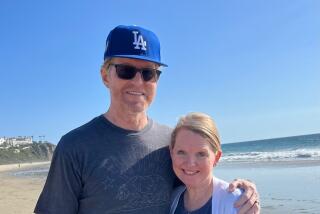Column: Decade after paralyzing accident, Jack Jablonski confident he will walk again
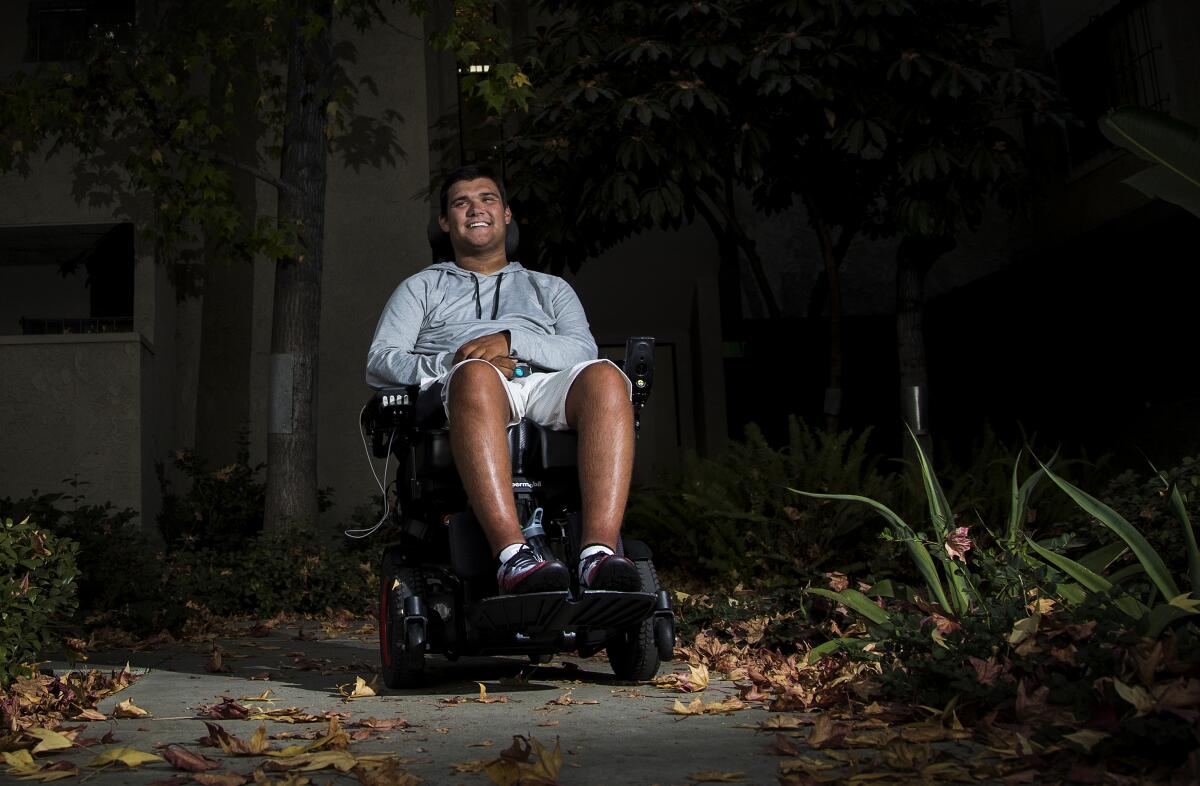
- Share via
There’s really no way to explain it.
A decade after an illegal check from behind during a Minnesota high school hockey game sent Jack Jablonski head-first into the boards, severing his spinal cord and leaving him paralyzed, Jablonski still has the sensation he’s wearing his skates.
He knows he’s not actually wearing them. He knows he is sitting in a motorized wheelchair most of the time, using one pinkie knuckle to type and produce content for the Kings’ website — which he basically runs — or to operate the devices he uses to conduct incisive interviews for feature stories and for a new web series called “Tradin’ Jabs.”
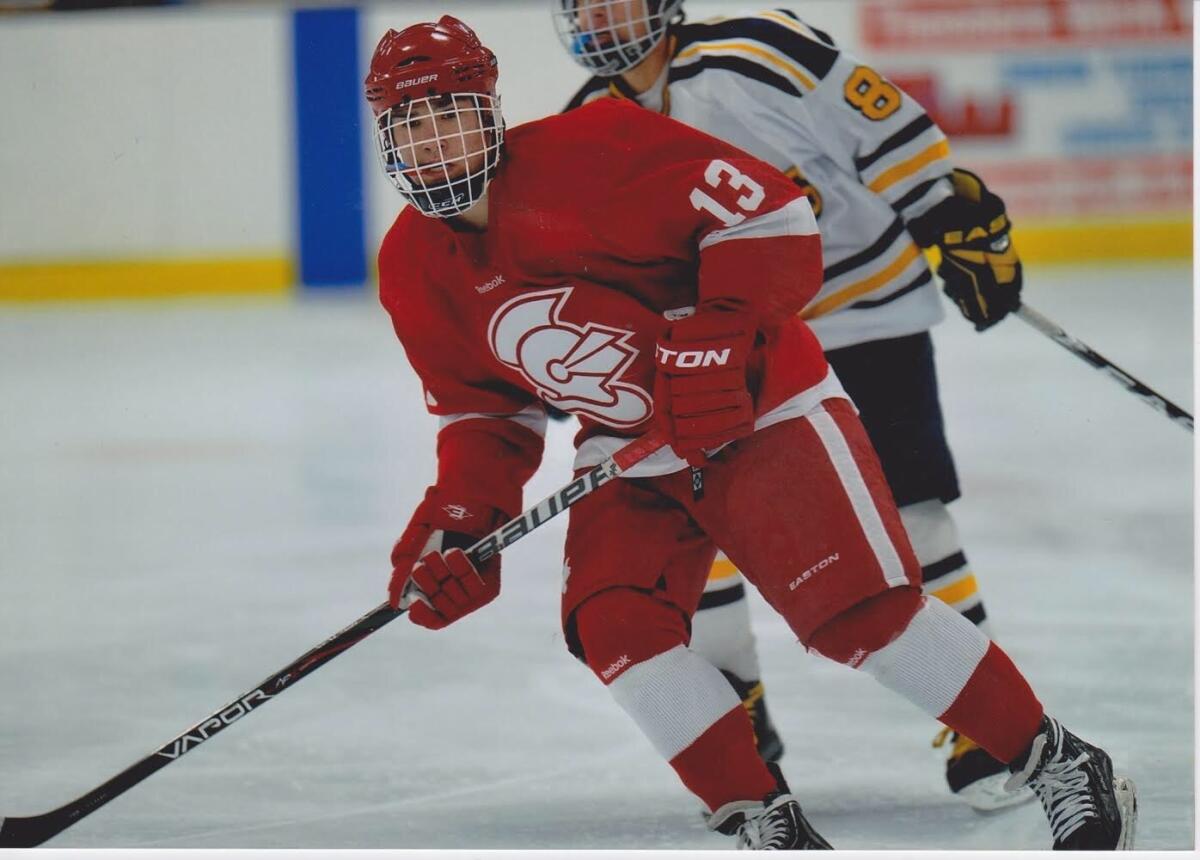
But playing hockey was so much a part of who he was that his mind tells him his skates are laced onto his feet and ready to carry him away, allowing him to keep one small part of his old life while he pushes the boundaries of the new life that began when he fell to the ice in a terrible heap on Dec. 30, 2011.
“It’s so weird. That’s the last feeling my feet had. Whenever I really think about it, it still feels like that. They’re just locked in those boots and still have the blades on,” he said.
“But regardless of whether you can see your toes or not, that’s just the feeling that I last remember and it’s still with me to this day. Hopefully I’ll be able to feel that again in true form.”
Jack Jablonski, who was left paralyzed by a collision during a high school hockey game in 2011, hasn’t let his condition stop him from graduating from USC and staying optimistic about what comes next.
Jablonski, 26, is approaching the 10-year anniversary of his accident with deep appreciation for those who have helped him get this far and infinite hope he will regain enough function in his limbs to reduce his now-complete dependence on a caregiver. He doesn’t know when that will happen or what forms the gains will take but he is sure that ongoing research will open new horizons for him and others who live with devastating spinal cord injuries.
“I truly believe I will walk,” he said, “and I hope to skate one day.”
Jablonski planned to spend the anniversary of his accident with his family in his hometown of Minneapolis. They will watch hockey on TV, of course, and he wants the day to be a celebration rather than a pity party. He is pushing aside the pessimism that sometimes seeps into his thinking, as happened when the COVID-19 shutdown became a torment of isolation and uncertainty. His accident had taken playing hockey away from him and then the pandemic took away televised hockey and most other sports, leaving him no games to write about or watch. He copes best when he’s busy and he had little to keep him occupied.
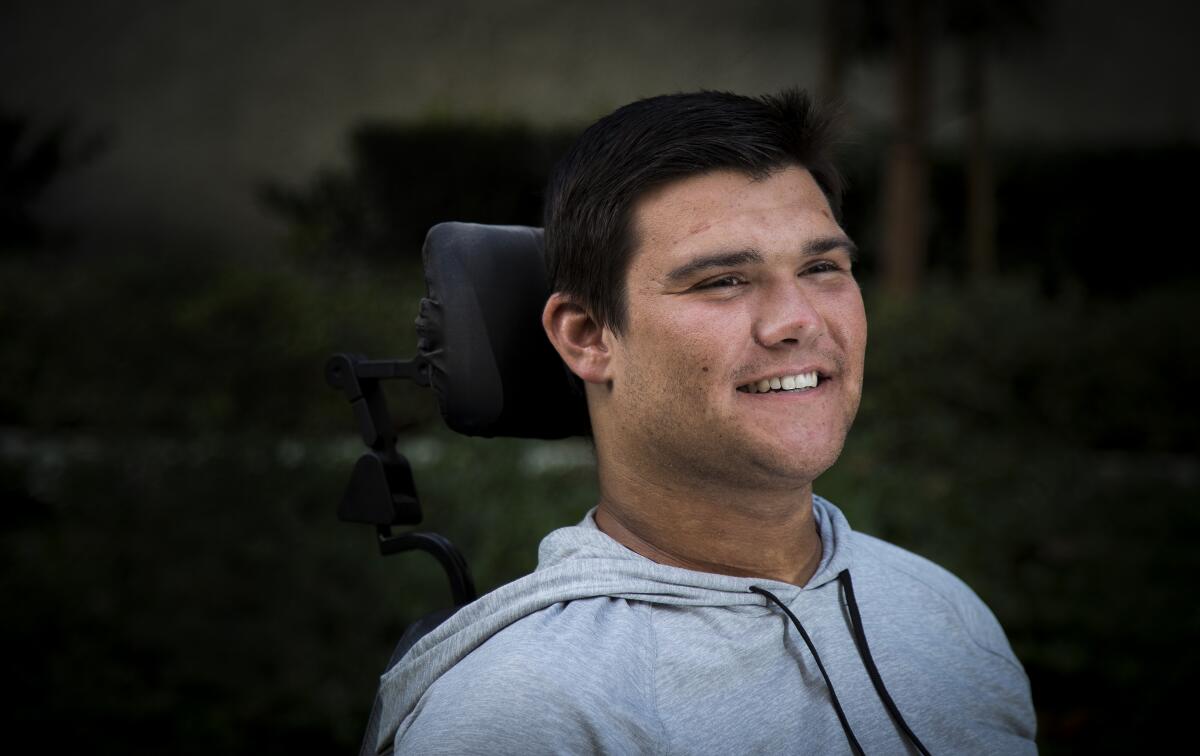
“I don’t think people realize the severity of life with paralysis unless they have it, they live with someone who has it, or they’re close to someone who has it.”
— Jack Jablonski
“When you’re alone your mind wanders and tends to go to a pretty dark place because of the past and the what-ifs and the reality of my situation,” said Jablonski, who attended USC on a “Swim with Mike” scholarship for physically challenged athletes and began working for the Kings as an intern before he graduated in 2019.
“I’ve gone down the rabbit hole, unfortunately, a few times here and there but fortunately I was able to not fall into too deep of a rut.”
With sports back, and with greater professional responsibilities he hopes will prepare him for a career in hockey operations and research into paralysis offering promising gains, he is looking ahead confidently.
“We are making medical advancements,” he said, “and whether it’s two years, five years, 10 years, 15 years down the road, I’m in it for the long haul. I believe that the way things are going in terms of the research and how rapidly they’re developing just in the 10 years that I’ve been in this world, I think most importantly, people’s lives will improve dramatically with paralysis in the next years to come. But all in all, I believe that we’ll have the cure to paralysis or at the very most an opportunity for people like myself to get back on our feet.”
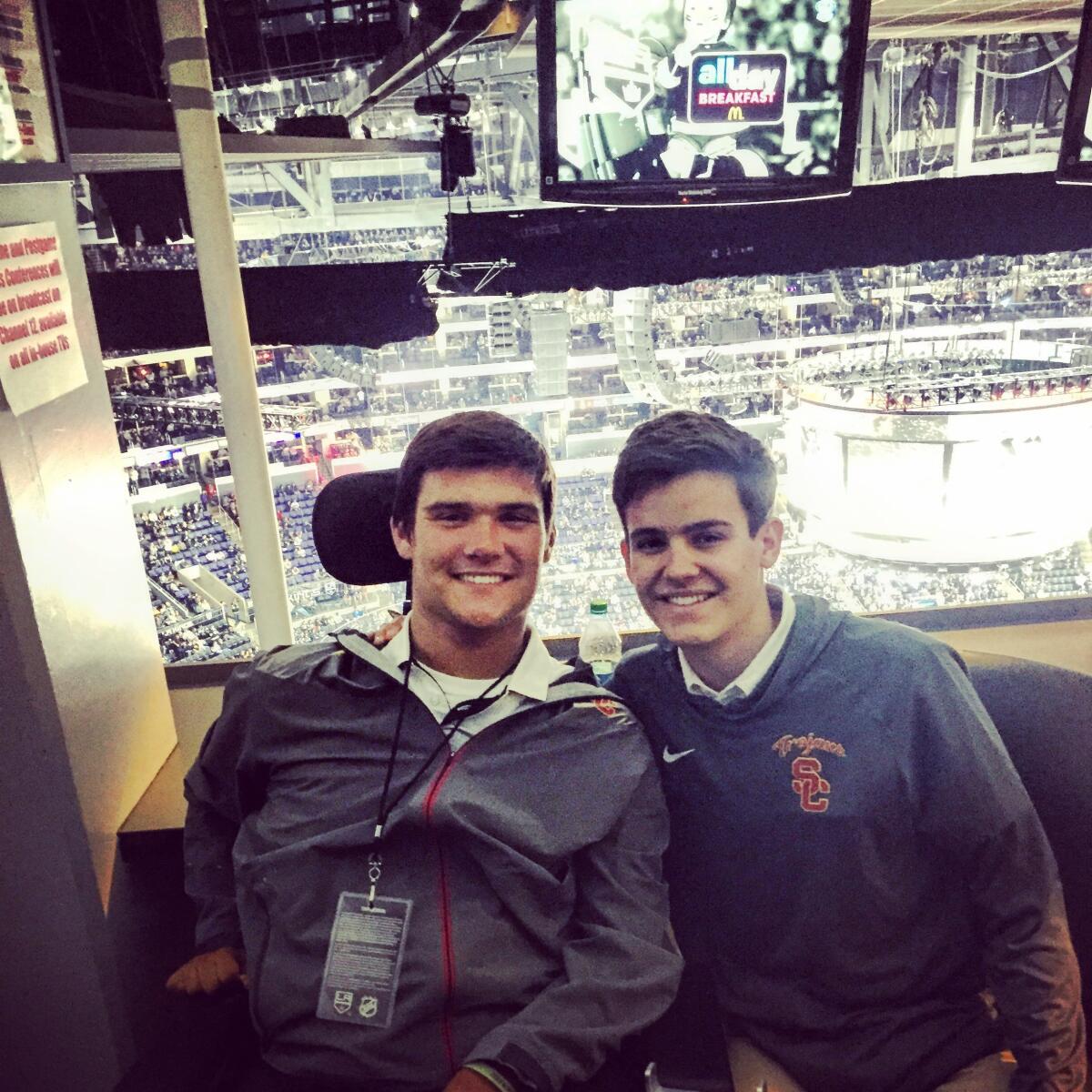
He’s helping make that happen by raising funds for research. The Jack Jablonski BEL13VE in Miracles Foundation — 13 was his uniform number at Benilde-St. Margaret’s High School — is run by a board with more than 20 members and carefully chooses which organizations it will support from the proceeds of its three annual events.
He’s also participating in a clinical trial led by Dr. V. Reggie Edgerton, who runs a neuromuscular research lab at UCLA. Edgerton also launched SpineX, a company that uses electrical stimulation devices to stimulate the spinal cord and alleviate various conditions. “For a USC guy, I’m willing to part ways with the rivalry and work together,” Jablonski joked.
He hasn’t yet participated in the trial on a regular basis, but his initial assessment was encouraging: stimulation of muscles through electrodes placed on his skin gave him a feeling of more control in his hand. “I was able to pour some water with a glass, which I haven’t been able to do in 10 years,” he said.
“One of the things that keeps you optimistic is all of the people we have seen do this study so far have had some positive results in one way or another, so we know that the trial study is working for those who are in it, which is obviously a confidence-booster for me being a part of it, going into it. This has potential to impact thousands, if not millions of people, if this can continue to prove that it does work in some way or another. Most importantly is improving people’s quality of life with paralysis. I don’t think people realize the severity of life with paralysis unless they have it, they live with someone who has it, or they’re close to someone who has it.”
Relying on his mind to prevail over limbs that had become paralyzed after he was driven face-first into the boards during a Minnesota high school hockey game nearly six years ago, Jack Jablonski stared at his feet one recent night and willed them to move.
Jablonski goes to therapy three times a week. Twice a week he is strapped into a standing frame and walks on a treadmill. “To stay in shape for when those medical trials and advances come around, to stay ready for the future,” he said.
His spine was broken, but his spirit is admirably whole. “If you would have asked me 10 years ago when I was laying in a hospital bed after my injury where would I be in 10 years I don’t think I could have pictured a better place for me,” he said. “I don’t think I could have pictured a better outcome from where I am today.”
More to Read
Go beyond the scoreboard
Get the latest on L.A.'s teams in the daily Sports Report newsletter.
You may occasionally receive promotional content from the Los Angeles Times.

